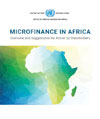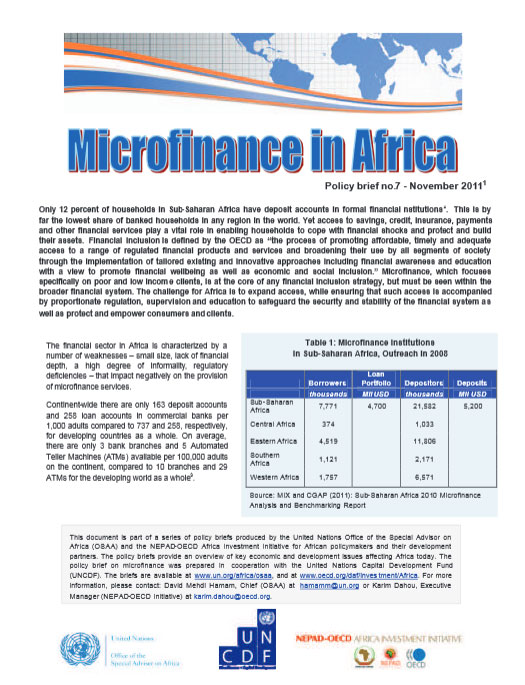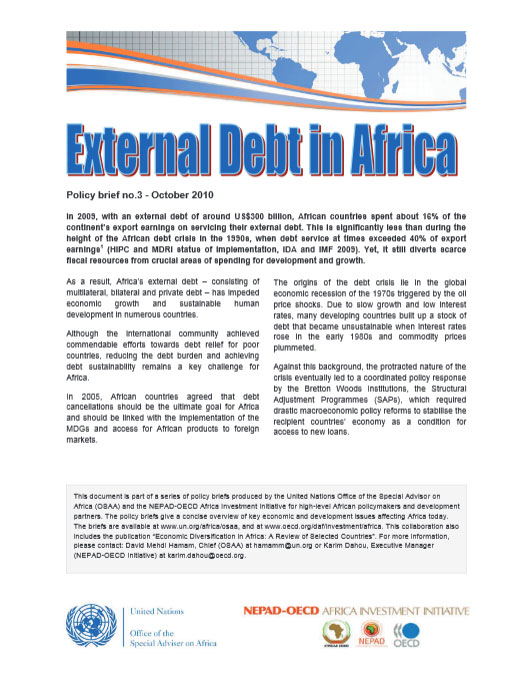Publications by OSAA
Financing Africa's Infrastructure Development (Policy Brief, OSAA, 2015) 
 Infrastructure deficit, hard and soft, has been undermining all the efforts towards achieving sustainable development and structural transformation in Africa, particularly in view of a rapidly growing population. It is urgent to provide well-functioning regional and national infrastructure, including roads, railways and ports, information and communication technology, energy facilities and health facilities, and the management of water. Accordingly, African leaders have made infrastructure development a pillar of the development strategy of the continent.
Infrastructure deficit, hard and soft, has been undermining all the efforts towards achieving sustainable development and structural transformation in Africa, particularly in view of a rapidly growing population. It is urgent to provide well-functioning regional and national infrastructure, including roads, railways and ports, information and communication technology, energy facilities and health facilities, and the management of water. Accordingly, African leaders have made infrastructure development a pillar of the development strategy of the continent.
Infrastructure and Development Within the Context of Africa's Cooperation with New and Emerging Development Partners (OSAA-NEPAD, 2015) 
 This report focuses on the participation of Africa’s seven new and emerging partners (NEPs) in Africa’s infrastructural development – Brazil, China, India, Korea, Malaysia, Russia and Turkey (hereafter the NEP7 economies). By drawing on the World Bank’s PPIAF database and complementing this with an extensive search of the internet and information provided by key informants, the report provide an important insight into the rapidly growing presence of NEP economies in Africa’s infrastructural sectors, and the distinctive character of this involvement.
This report focuses on the participation of Africa’s seven new and emerging partners (NEPs) in Africa’s infrastructural development – Brazil, China, India, Korea, Malaysia, Russia and Turkey (hereafter the NEP7 economies). By drawing on the World Bank’s PPIAF database and complementing this with an extensive search of the internet and information provided by key informants, the report provide an important insight into the rapidly growing presence of NEP economies in Africa’s infrastructural sectors, and the distinctive character of this involvement.
Microfinance in Africa - Overview and Suggestions for Action by Stakeholders (OSAA, 2015) 
 Even if microfinance on its own is not a miracle solution to eradicate poverty, it is proving vital to empowering entire communities. This report is about how to effectively harness the development potential of microfinance in Africa to lift its poor out of poverty and reduce their vulnerability. It proposes innovative policy measures and actions for empowering African people through enhanced access to, and use of, microfinance.
Even if microfinance on its own is not a miracle solution to eradicate poverty, it is proving vital to empowering entire communities. This report is about how to effectively harness the development potential of microfinance in Africa to lift its poor out of poverty and reduce their vulnerability. It proposes innovative policy measures and actions for empowering African people through enhanced access to, and use of, microfinance.
Main Economic Indicators (Fact Sheet, OSAA, 2014) 
 This Fact Sheet is a snapshot of important economic indicators for Africa in recent years. It provides an overview of various statistics and assesses elements of growth, economic structure, foreign trade, foreign direct investment (FDI), official development assistance (ODA), debt and remittances of African economies.
This Fact Sheet is a snapshot of important economic indicators for Africa in recent years. It provides an overview of various statistics and assesses elements of growth, economic structure, foreign trade, foreign direct investment (FDI), official development assistance (ODA), debt and remittances of African economies.
Africa's Decade of Change -
Reflections on 10 Years of NEPAD (NEPAD, UNECA, OSAA, 2013) 
 This publication is a reflective commemoration of NEPAD and a look ahead at what is to come, both for NEPAD and the continent at large. The next decade of development in Africa must be driven by renewed efforts towards increasing ownership and maximizing Africa’s own internal potential, resources and talents for the continent’s development. Many challenges and opportunities lie ahead. Africa will only succeed if it continues on its path of comprehensive political and socio-economic reforms, hinged on the core values of strong African ownership, leadership and value-driven partnership.
This publication is a reflective commemoration of NEPAD and a look ahead at what is to come, both for NEPAD and the continent at large. The next decade of development in Africa must be driven by renewed efforts towards increasing ownership and maximizing Africa’s own internal potential, resources and talents for the continent’s development. Many challenges and opportunities lie ahead. Africa will only succeed if it continues on its path of comprehensive political and socio-economic reforms, hinged on the core values of strong African ownership, leadership and value-driven partnership.
Main Economic Indicators (Fact Sheet, OSAA, 2011) 
 This fact sheet provides a snapshot of key economic indicators in Africa since 2005. It inclu des statistics and analysis for Gross Domestic Product, the structure of African economies, foreign trade, f oreign direct investment, official development assistance, external debt and remittances.
This fact sheet provides a snapshot of key economic indicators in Africa since 2005. It inclu des statistics and analysis for Gross Domestic Product, the structure of African economies, foreign trade, f oreign direct investment, official development assistance, external debt and remittances.
Economic Diversification in Africa - A Review of Selected Countries (OECD, OSAA, NEPAD, 2011) 
 The global financial and economic crisis has revealed Africa’s vulnerability to external economic shocks. Largely dependent on the export of commodities, many of the continent’s economies suffered setbacks in economic growth and in their efforts to meet the MDGs by 2015. Economic diversification holds great potential to increase Africa’s resilience and would contribute to achieving and sustaining long term economic growth and development in the continent. Broadly-based economies, active in a wide range of sectors, and firmly integrated into their regions, are better able to generate robust growth and sustainable growth. This study analyses the economies of Angola, Benin, Kenya, South Africa, and Tunisia and their diversification profiles and strategies.
The global financial and economic crisis has revealed Africa’s vulnerability to external economic shocks. Largely dependent on the export of commodities, many of the continent’s economies suffered setbacks in economic growth and in their efforts to meet the MDGs by 2015. Economic diversification holds great potential to increase Africa’s resilience and would contribute to achieving and sustaining long term economic growth and development in the continent. Broadly-based economies, active in a wide range of sectors, and firmly integrated into their regions, are better able to generate robust growth and sustainable growth. This study analyses the economies of Angola, Benin, Kenya, South Africa, and Tunisia and their diversification profiles and strategies.
Microfinance in Africa (Policy Brief, OSAA, 2011) 
 Only 12% of households in Sub-Saharan Africa have deposit accounts in formal financial institutions. Yet access to savings, credit, insurance, payments and other financial services play a vital role in enabling households to cope with financial shocks and protect and build their assets. Microfinance, as part of the braoder financial system, is at the core of any financial inclusion strategy. The challenge for Africa is to expand access, while ensuring that such access is accompanied by proportionate regulation, supervision and education to safeguard the security and stability of the financial system as well as protect and empower consumers and clients.
Only 12% of households in Sub-Saharan Africa have deposit accounts in formal financial institutions. Yet access to savings, credit, insurance, payments and other financial services play a vital role in enabling households to cope with financial shocks and protect and build their assets. Microfinance, as part of the braoder financial system, is at the core of any financial inclusion strategy. The challenge for Africa is to expand access, while ensuring that such access is accompanied by proportionate regulation, supervision and education to safeguard the security and stability of the financial system as well as protect and empower consumers and clients.
Africa's Terms of Trade after the Crisis (Policy Brief, OSAA, 2011) 
 Terms of trade are a measure of the changing price levels of a country’s exports and imports over time. They have been an important tool to analyze African LDCs' participation in world trade. In 2009, African LDCs'’ aggregated terms of trade were less favorable compared to 2006 levels, and significantly less compared to 2008 levels. In 2010 a modest recovery is observed. This is in part due to the recovery of export earnings to pre-crisis levels. In the context of increasing commodity prices, there is cause for cautious optimism for African LDCs' terms of trade in the near future. Nonetheless, they remain vulnerable to future strong terms of trade shocks due to the limited diversification of export products.
Terms of trade are a measure of the changing price levels of a country’s exports and imports over time. They have been an important tool to analyze African LDCs' participation in world trade. In 2009, African LDCs'’ aggregated terms of trade were less favorable compared to 2006 levels, and significantly less compared to 2008 levels. In 2010 a modest recovery is observed. This is in part due to the recovery of export earnings to pre-crisis levels. In the context of increasing commodity prices, there is cause for cautious optimism for African LDCs' terms of trade in the near future. Nonetheless, they remain vulnerable to future strong terms of trade shocks due to the limited diversification of export products.
Africa's Progress Towards the MDGs (Policy Brief, OSAA, 2011) 
 In 2000 world leaders gathered at the UN Headquarters in New York to adopt the Millennium Declaration, committing their nations to a global partnership to reduce extreme poverty by 2015. The eight Millennium Development Goals (MDGs) cover key socio-economic and human development issues and give the global community a basis on which to fight poverty and under-development.
In 2000 world leaders gathered at the UN Headquarters in New York to adopt the Millennium Declaration, committing their nations to a global partnership to reduce extreme poverty by 2015. The eight Millennium Development Goals (MDGs) cover key socio-economic and human development issues and give the global community a basis on which to fight poverty and under-development.
Tax and Development in Africa (Policy Brief, OSAA, 2011) 
 Taxation is an integral part of development policy. It provides governments with a predictable and stable flow of revenue to finance development objectives such as infrastructure, shapes the way government activities are undertaken, and plays a central role in domestic resource mobilisation.
Taxation is an integral part of development policy. It provides governments with a predictable and stable flow of revenue to finance development objectives such as infrastructure, shapes the way government activities are undertaken, and plays a central role in domestic resource mobilisation.
Africa's Cooperation with New and Emerging Development Partners: Options for Africa's Development (OSAA, 2010) 
 The global economy and polity is now entering a period of disruptive change and punctuated equilibrium. This report summarises the interaction of Africa with emerging economies on three vectors of integration — aid, trade and FDI within this disruptive period. Individual profiles for China, India, Brazil, Korea, Malaysia, Russia and Turkey document the changing importance of Africa for these emerging economies. The emerging economies in general, and China in particular, exercise a much closer strategic integration of aid, trade and FDI. This position is fairly distinct from the emerging pattern of best-practice aid, trade and FDI from the OECD economies.
The global economy and polity is now entering a period of disruptive change and punctuated equilibrium. This report summarises the interaction of Africa with emerging economies on three vectors of integration — aid, trade and FDI within this disruptive period. Individual profiles for China, India, Brazil, Korea, Malaysia, Russia and Turkey document the changing importance of Africa for these emerging economies. The emerging economies in general, and China in particular, exercise a much closer strategic integration of aid, trade and FDI. This position is fairly distinct from the emerging pattern of best-practice aid, trade and FDI from the OECD economies.
Foreign Direct Investment (FDI) in Africa (Policy Brief, OSAA, 2010) 
 Over the past two decades, foreign direct investment (FDI) has become a vital source of economic development for the African continent. With an increase from approximately US$ 9 billion in 2000 to US$ 18 billion in 2004 and US$ 88 billion in 2008, FDI has become a major source of finance for Africa’s development.
Over the past two decades, foreign direct investment (FDI) has become a vital source of economic development for the African continent. With an increase from approximately US$ 9 billion in 2000 to US$ 18 billion in 2004 and US$ 88 billion in 2008, FDI has become a major source of finance for Africa’s development.
External Debt in Africa (Policy Brief, OSAA, 2010) 
 In 2009, with an external debt of around US$ 300 billion, African countries spent about 16% of the continent’s export earnings on servicing their external debt. This is significantly less than during the height of the African debt crisis in the 1990s, when debt service at times exceeded 40% of export earnings (HIPC and MDRI status of implementation, IDA and IMF 2009). Yet, it still diverts scarce fiscal resources from crucial areas of spending for development and growth.
In 2009, with an external debt of around US$ 300 billion, African countries spent about 16% of the continent’s export earnings on servicing their external debt. This is significantly less than during the height of the African debt crisis in the 1990s, when debt service at times exceeded 40% of export earnings (HIPC and MDRI status of implementation, IDA and IMF 2009). Yet, it still diverts scarce fiscal resources from crucial areas of spending for development and growth.
Infrastructure in Africa (Policy Brief, OSAA, 2010) 
 Bridging Africa’s infrastructure gap is key to overcoming the continent’s development challenges. Road and rail systems make trade and investment possible; electricity facilitates mining, manufacturing and commercial activities; irrigation is critical for unlocking Africa’s agriculture potential; communication technologies can support product marketing and facilitate financial transactions;and access to clean water and sanitation helps to improve health and education services and prevent the spread of disease.
Bridging Africa’s infrastructure gap is key to overcoming the continent’s development challenges. Road and rail systems make trade and investment possible; electricity facilitates mining, manufacturing and commercial activities; irrigation is critical for unlocking Africa’s agriculture potential; communication technologies can support product marketing and facilitate financial transactions;and access to clean water and sanitation helps to improve health and education services and prevent the spread of disease.
Aid to Africa (Policy Brief, OSAA, 2010) 
 Africa receives a greater share, at 36%, of total global aid than any other part of the world. Over the past four decades, aid to Africa has quadrupled from around US$ 11 billion to US$ 44 billion, with a net increase of almost US$ 10 billion during the period 2005-2008 alone.
Africa receives a greater share, at 36%, of total global aid than any other part of the world. Over the past four decades, aid to Africa has quadrupled from around US$ 11 billion to US$ 44 billion, with a net increase of almost US$ 10 billion during the period 2005-2008 alone.

